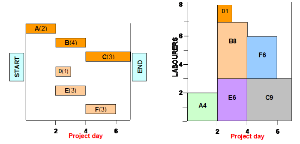Resource levelling – part 1 - Summary
General
Clearly resource needs cannot be eliminated just by having as much of it as you wish.
The procurement of the resource is one issue and the efficient use of that resource is another.
Control over resources is only possible for those tasks under your control as the contractor.
Hence, sub-contractor resource issues are beyond your control.
Remember that resource covers materials, equipment and labour.
The principle of resource ‘levelling’ is the same for each but more complicated when you are trying to level more than one resource.
Once you have produced a project schedule of the tasks alone the next step is to modify it according to the availability of resources.
Once those resources have been considered [see Resource procurement – part 1] the new schedule will reflect any problem areas and may include specific sub-projects for resource procurement.
However, once the resource is in place it is not usual for it to be used evenly over all of the tasks.
The labour force is special in this sense as the ‘stop start’ attitude to working tends to reduce efficiency.
Even in the case of equipment someone is usually responsible for its operation.
For these reasons of efficiency it is often best to consider ‘spreading’ the resource out more evenly which will reduce the need for a ‘stop start’ mentality to the project.
The need to level resource is not only a factor of availability. If you have two sets of workers operating at the same time it may be inconvenient or dangerous for them to work in close proximity. You may then need to level the resource.
The process of levelling is also known as ‘smoothing’ or ‘balancing’.
We can demonstrate the basic principles by looking at the labour and equipment resource for a simple project.
The principle of refining the schedule will carry on until you are happy with it or you run out of time.
Simple example
The diagram below shows a simple project schedule of 6 tasks.
The values in brackets show the labour needed for each task, so we have:
Task #A = 2 workers
Task #B = 4 workers
Task #C = 3 workers
Task #D = 1 workers
Task #E = 3 workers
Task #F = 3 workers
We can summarise the workers used on each day using a histogram, as shown in the second of the diagrams.
We can see the following information.
Task #A = 2 workers for project days 1 and 2
Task #B = 4 workers for project days 3 and 4
Task #C = 3 workers for project days 5, 6 and 7
Task #D = 1 workers for project days 3
Task #E = 3 workers for project days 3 and 4
Task #F = 3 workers for project days 5 and 6
The histogram gives a graphical display of the total number of workers for each day. So, we have:
Project day 1 = 2 workers
Project day 2 = 2 workers
Project day 3 = 7 workers
Project day 4 = 6 workers
Project day 5 = 6 workers
Project day 6 = 6 workers
Project day 7 = 3 workers
The overall total work force = 32
If we were able to ‘level’ the resource over 7 days it would be 32 / 7 = 4.6 or 5 workers to the nearest whole number.
Hence, in an ideal situation you would like to have about 5 workers every day.
This may not be possible to achieve without losing out in other areas but there is a technique to consider.
The histogram is based upon the Earliest Start Time (EST) of each task and a ‘spread’ of the workforce over the duration of the task.
Notice that the ‘area’ under each ‘block’ represents the ‘man-days’ used for each task.
For example, task ‘C’ lasts 3 days and uses 3 workers each day = 3 x 3 man-days = 9 man-days (the pale grey box in the histogram).
Under PRINCE2® 2009 planning is covered by the Plans theme.
The purpose of the Plans theme is to facilitate communication and control by defining the means of delivering the products (the where and how, by whom, and estimating the when and how much).
[see Plans - Purpose]
A plan can only show the ultimate feasibility of achieving its objectives when the activities are put together in a schedule that defines when each activity will be carried out.
[See Plans - The PRINCE2 approach - Prepare the schedule]
PRINCE2 2009 [see ‘The Complete Project Management plus PRINCE2’] describes resource levelling.
The first allocation of resources may lead to uneven resource usage or over-utilization of some resources.
It may therefore be necessary to rearrange resources – this is called levelling.
Activities may be reassigned, or they may have start dates and durations changed within the slack available.
The end result is a final schedule with all activities assigned and resource utilization equating to resource availability. [see Plans - The PRINCE2 approach - Prepare the schedule - Level resource usage]
PRINCE2® is a Registered Trade Mark of the Office of Government Commerce in the United Kingdom and other countries.



